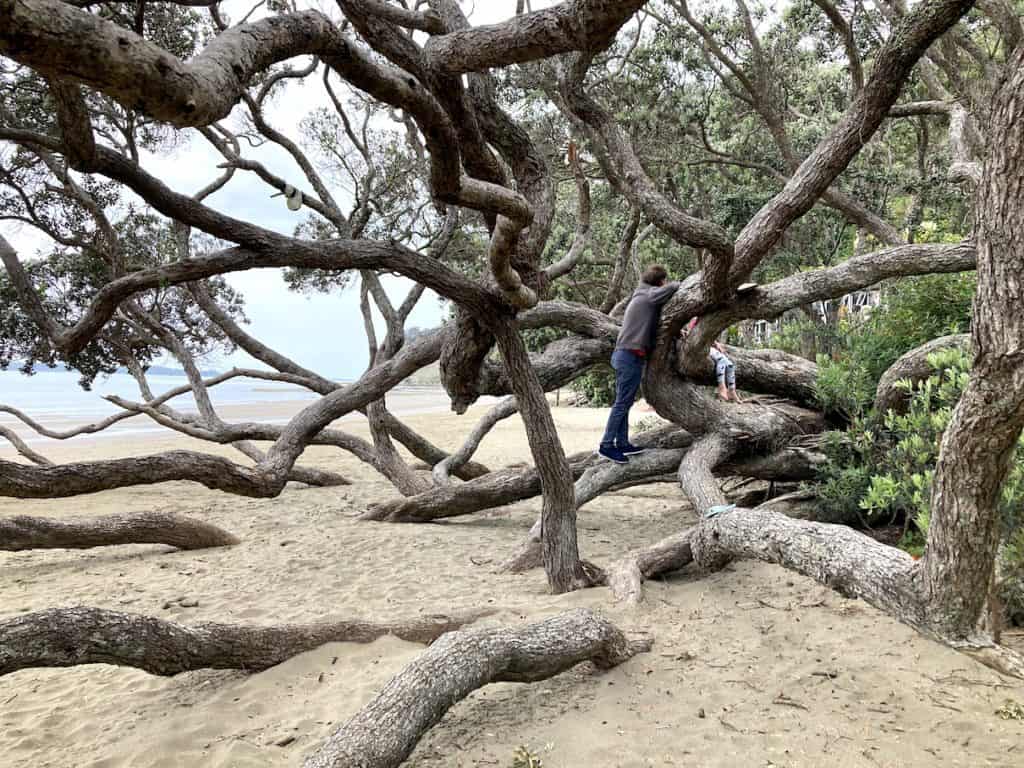
Tree climbing for children is inevitable.
We can all predict what happens next when a child finds a tree with low branches. They climb it. And if you happen to blink, they will climb to a dangerous height out of reach, by the time your eyes open again. So how do we teach our kids to climb trees safely?
In our family, we’ve adopted a gradual and balanced approach to tree climbing. As each child’s ability grows, we match the difficulty of the tree with them. This has meant we’ve been able to gradually step back and let them judge more and more what feels safe. And monitor our own heart rate.
I think it’s important to let children develop their sense of risk taking and feed their hunger for adventure. However, as their caregivers it’s important to find a way to keep them safe. It will take time and many attempts to help them navigate the safety vs the risk.
Every childhood needs a tree to climb
We all have a childhood memory of climbing a tree. I remember feeling pure determination to climb a particular big tree in our back garden (well it was big to my 4 year-old self). My brother (6) and his neighbourhood friend had figured out how to get to the top. They declared it their club house. If I wanted to join, I had to figure out how to climb up by myself. Challenge accepted.
My brother also fell out of that tree, and it was a pretty hard landing from memory. (He’s all good now with no lasting damage). After that, I remember my dad sawing off the lower limbs of the tree so we couldn’t get up again.
Do you think that stopped us for long?
I have close up memories of looking at the sawn off tree-limbs and determining to find a path up. My brother and his friend figured it out in an afternoon. I remember the rough bark tearing at my hands, ignoring the tickle of ants crawling over my legs, and the exhalation of pulling myself up and realising the cut-off branch made an excellent foot hold for the next step.
How is that NOT an excellent life experience of my formative years?
Disclaimer; I’m not a doctor or medical professional. The words in this post are only my thoughts and opinions and if you choose to act on any suggestions those are your own decisions and responsibility.
Why does my child climb everything?
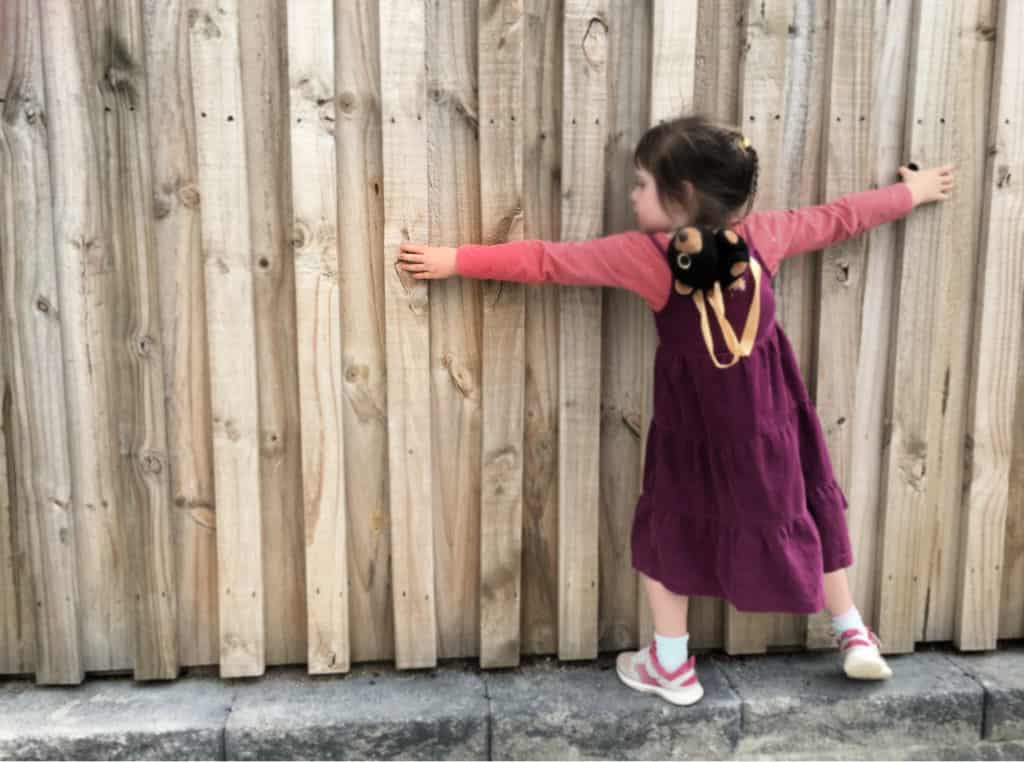
Kids are compulsive about climbing. They are hardwired to explore the world from as many different perspectives as possible, feeding the brain’s impulse to develop as many new pathways as it can.
Kids need to experience fear and learn to deal with it. It’s evolution’s way of priming us to adapt to new situations and grow. Peter Gray, Ph D. and author of Free to Learn breaks down different types of risky play, and why it’s important for them.
I guess it’s how humanity has evolved to the point we have. In a young mind, risky play forms the foundation of some critical coping mechanisms for life.
If you think about it, climbing high is thrilling and can make your knees turn to jelly, but you have to keep a calm head to stay safe. In other words, it taps right into the development of emotional regulation and dealing with fear and uncertainty.
9 reasons why tree climbing is good for children
Risky play is more important than ever for our younger generation. As they learn how to get from that first branch to the second higher-up branch, their minds and bodies are evaluating their capabilities, but at some point they’ll have to bet on themselves and find out if they actually are capable. And if not today, maybe they’ll try again tomorrow, a little stronger, a little wiser. So it grows their persistence too.
1. Tree climbing helps with evaluating risk taking.
Learning to figure out how dangerous or safe something is, can only be done by taking risks. Gradually building an understanding of things in the natural world like gravity, informs a child’s calculation of risk.
When you guid your children through risky play, it allows them to develop risk management. This means they are actually less likely to get seriously hurt.
2. Tree climbing increases resiliency
Mistakes are learning gold. In our house, we call cuts and scrapes ‘Tough Girl Cuts’. Because the more bangs you experience, the tougher you become. The more you know you’ll get through to the other side of hard moments.
3. Tree climbing builds physical strength and ability
Climbing is a full-body workout. It increases their strength and coordination, works on gross motor skills and cognitive development with cross-brain activity. They practice balance.
4. Risky play builds emotional development
Overcoming fears, feeling thrilled with excitement and a sense of danger at the same time and learning to keep it under control so they can stay calm and focused on not falling.
5. Tree climbing grows perspective and awareness
Seeing the world from a new angle and vantage point allows a child to physically and mentally step out of their usual perspective, and realise that sometimes all you need is to shift how you’re looking at things.
6. Tree climbing encourages ambition and perseverance
Wanting to be up as high as their sibling or friend, to be part of the tree gang or just to feel like they’ve mastered something. It might take several attempts, but they’ll notice that persistence pays off.
7. Risky play increases self-confidence
I think we can all imagine the immense sense of achievement a child must feel when they’ve managed to climb a tree, without falling.
Especially if it’s something they’ve been working on for a while, noticing themselves get stronger each time they try. This feeling can spark their sense of ‘being in control’ and lead to greater self-responsibility, autonomy, and initiative.
8. Tree climbing is all about experiencing nature
Being high in the branches of a tree is an opportunity to learn about nature and experience it.
You can talk to your children about the smaller details of the tree, like any bugs you find, or new growth, the seasons. Trees can be home to other creatures and if there is a nest, talk about why they shouldn’t touch it. Or not to get a fright and fall. You can identify the kind of tree it is and any other facts about it you know.
9. A well known tree can be their special place
Imagine them: Resting their heads back on a sturdy branch of their favourite, well-climbed tree, feeling glorious from the physical and emotional exertion and independence. Watching the world go by from an altered perspective and their imagination starts to stir.
Having a quiet place to hang out and ponder is a magical gift for their childhood.
What can go wrong when tree climbing with kids?
Of course, serious accidents and injuries can happen when climb trees. I’m not diminishing the care that needs to be taken as kids learn to match their yearning for adventure with their abilities.
It’s especially important for younger pre-school-aged children that an adult be there to supervise and spot them as they gradually build their skills and confidence. Below are a few hazards to consider:
- Watch out for weak or rotten branches as they can break.
- Dangerous creepy crawlies in the trees, keep an eye out for wasp nests or beehives
- If they climb too high and can’t get down. Remember, climbing down can be more daunting and scarier than climbing up. Maybe this is because they are looking down and see the ground where they might fall, or it’s using a different set of muscles that aren’t as strong.
- They slip and fall and seriously hurt themselves. While the studies that have been conducted on Risky Play report a relatively low incidence of serious injuries, it can happen. I think it’s important to remember to ask yourself whether the benefits of exploring outweigh the risk of injury. And to mitigate the risks, such as not climbing trees in bad weather as it’s easier to slip.
- You overwhelm your child by projecting onto them your own fears about them hurting themselves. This could lead them to freeze with fear or not trust their instincts.
Related post: How to make parenting more FUN
The modern childhood is very different from when we were kids.
With the rise of social media dominating life and the overwhelming feeling of being judged en-masse that comes with it, our kids will be less likely to take risks socially. A child who doesn’t take risks, doesn’t discover or grow.
Over the decades the opportunity for children to play freely, outside and in risky ways has diminished significantly. More populous cities means there is less outdoor space and access to large outdoor areas. Some of it is cultural, with emphasis on digital education and the increase of a child’s leisure time in front of a screen.
Not to mention the current trend for parenting styles to be more protective. We are far more risk averse as we have grown aware of the horrors some children are subjected to, which are significant and real.
What’s at risk if you don’t let your child have risky play like tree climbing?
It’s well documented that childhood mental disorders and cases of anxiety in children are on the rise. This didn’t use to be a thing.
Anxiety is the brain catastrophising about the future; ‘What if I don’t know how to…”, “What if I hurt myself when I…”. Sure, our brain is trying to protect us. It’s trying to prepare for all dangerous possibilities and what actions to take. Anxiety is when that gets out of control and we are no longer in the present.
Minimising your child’s access to risky play can impact their ability to learn. Risky play grows their understanding of the value of making mistakes. This means being able to reframe mistakes as an opportunity to improve or do better next time, is the foundation of an open mindset.
A child who has a fear of taking risks or being hurt could grow into an adult who constantly feels anxious and doesn’t take risks with life choices. There’s greater chance of depression and emotional resilience.
So, how does climbing a tree help with all this?
Not only reconnecting with nature, but the physical and mental work involved with climbing will bring them into the present and focus them on the here and now. Sitting on a branch watching the world from a new view point can shift headspace. Listening to up close rustling leaves and birds chirping, can drown out noisey mind-chatter. So, yeah. Go climb a tree.
Related post: Top parenting strategies
What makes a good climbing tree for your child?
If you’re worried about your child falling out of a tree, or a branch breaking, there’s a few pointers you can look out for when selecting a good climbing tree.
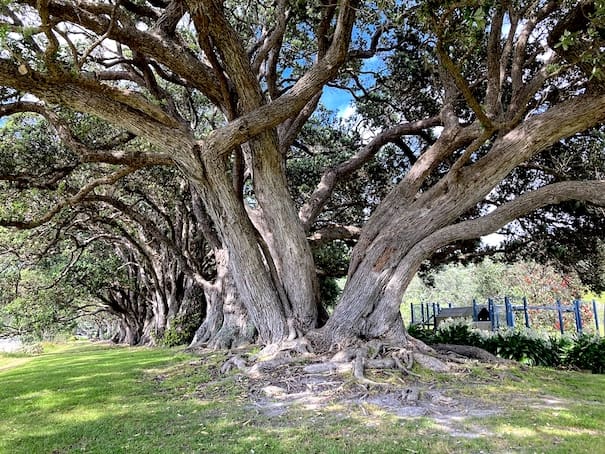
Type of tree: Choosing a tree that is hard wood like Pine or Oak means that the branches are likely to be stronger.
Roots & Canopy health: Rotting or spongey roots will indicate decay and may mean the branches as strong. Same with the canopy of leaves. If there are a lot of dying or unhealthy looking branches, best to give that tree a miss.
Age: Young small trees can be easy for a small child to clamber up in, but young trees are not strong enough and could be easily damaged. Older, well established trees tend to have lots of knots too, which make great foot holds.
Match child’s ability to the tree: If it looks like a tree that’s too high for you to climb if you have to get them down, then think twice.
How do I help my kids be safe when tree climbing?
We live in a time where it’s so easy to just solve our kids challenges by making their day-to-day path smooth. It’s a faster solution. Pick the child up, put them snuggly on a safe branch, tell them to hold on and smile. While we stand back, take a pic then post to instagram #bestlife #treeclimbing.
Here’s my tips for helping kids learn to climb safely:
| PATIENCE | Tree climbing takes is A LOT of patience. Mastering any skill takes hours of accumulated practice. A little bit like compound interest, but in a good way. If there’s a good climbing tree on the walk home from school, why not let them burn off some energy? I have to remind myself of this, when the schedule in my head is shouting at me. |
| RULES | At The Forest School, they do a lot of tree climbing and have simple, clear rules to follow when climbing, such as: * Stay Close to the Trunk * If It Doesn’t Feel Right Don’t Do It * Stay Off the Dead Branches |
| BUILD AWARENESS | Help them grow conscious of what they are doing and thinking by occasionally asking prompts as they climb: * Which branch can you reach next? * How does that branch feel when you put weight on it? * Does your foot feel steady there? * Have you got good grip before you move? * What’s your plan for getting down safely? |
| ENCOURAGEMENT | Give them words of encouragement as they overcome their fears, moving from one branch to the next. |
| STAY CLOSE | It’s important when they are young and are just beginning their tree climbing adventures, to be close by and spot them. You’re not necessarily lifting them and doing it for them, but if they know you’re there to help, it can keep them calm if they get overwhelmed or fall. |
| BALANCE | Check your own fears aren’t stopping them from learning and growing. It’s important to be there when they are young. However, staying aware of how involved you are and knowing when to step back and let them take responsibility for their risks is a vital step. |
Final thoughts on letting your child’s spidey-sense take over
The other day, my eldest daughter ran off to climb her favourite tree, out of sight in the front garden. I was hands deep in the dishes and absent-mindedly called out “Okay, don’t fall!”. Yep, such helpful advice. As if that would ever be her intention. It’s almost as helpful as “Be careful”.
Wanting to be more effective in my parenting instruction was what inspired me to write this post.
I’m very aware of not wanting to be a “Helicopter Parent”, always hovering to avert a conflict or physical pain. Neither do I want to be a parent who my child feels like she can’t come to for comfort when she’s hurt or has a problem. So, I think it’s a question of balancing my own anxieties against what is going to be a good experience for my child to learn from.
If we protect our kids through childhood from all the possible scrapes and injuries, we are stealing their chance to learn for themselves how to assess what hurts and what doesn’t. But more importantly, we are taking from them the opportunity to grow.
If you like this post please share, or get in touch and tell me what your thoughts are. I love hearing from my readers.
Lastly, if you want to know more about what I hope you’ll find at Not So Perfect Parenting, read my post on 5 Things I want to help my audience with.
Check out my other posts
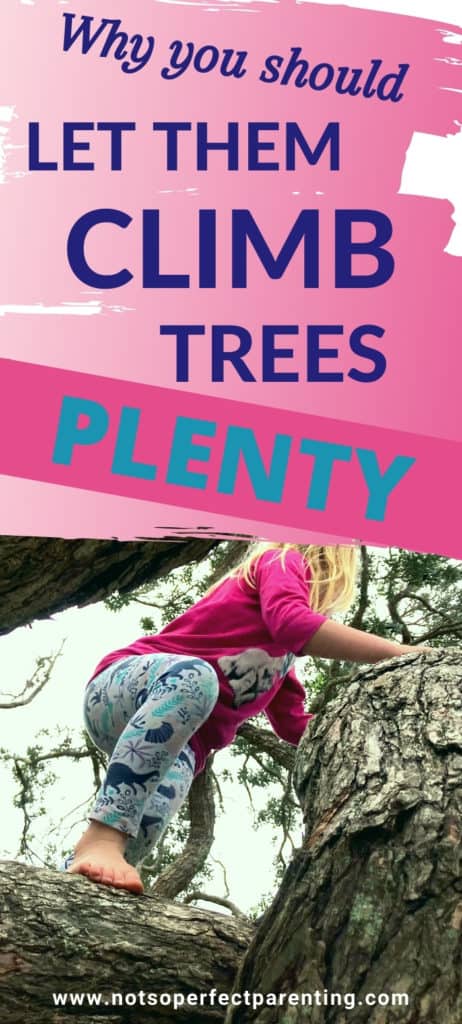

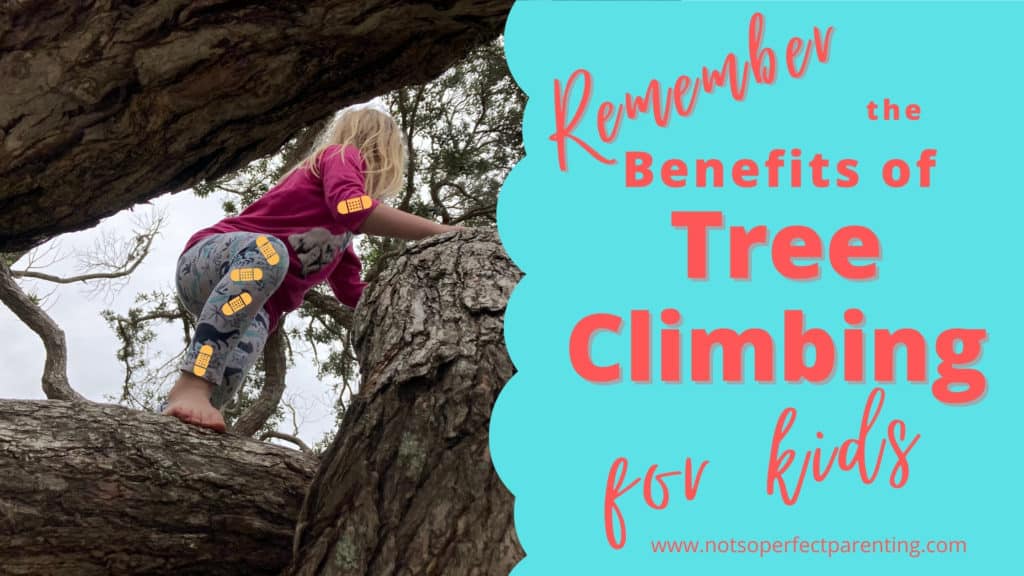
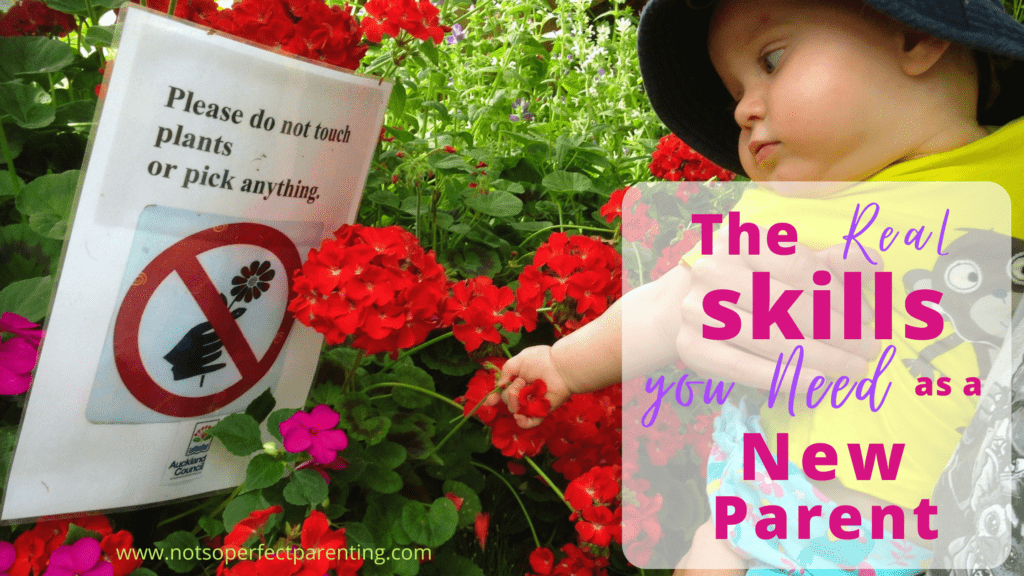
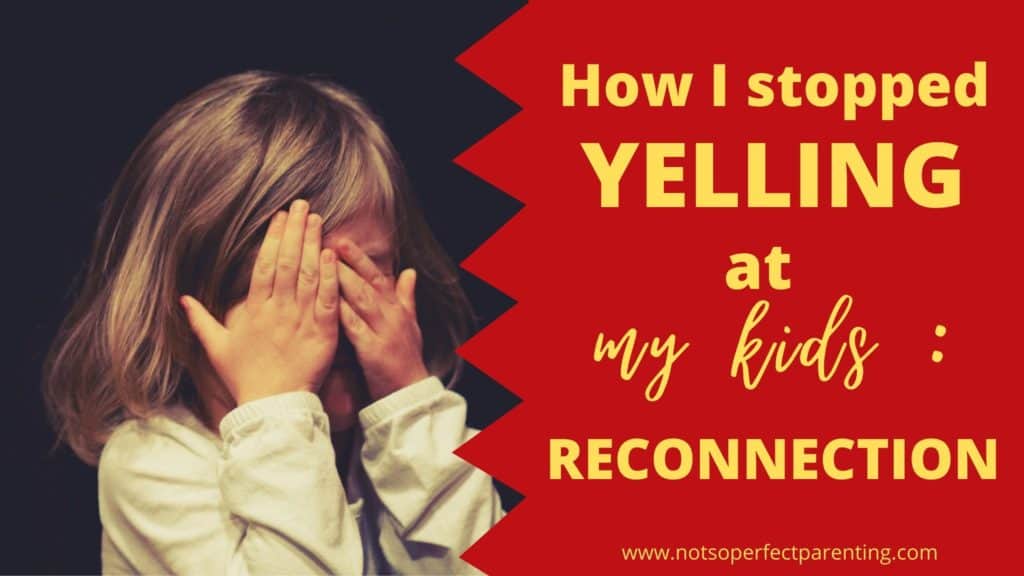


Hey Marion, You are great. You share very helpful information about Tree climbing benefits for children. Step By Step Explanation good try to understand Tree climbing benefits.